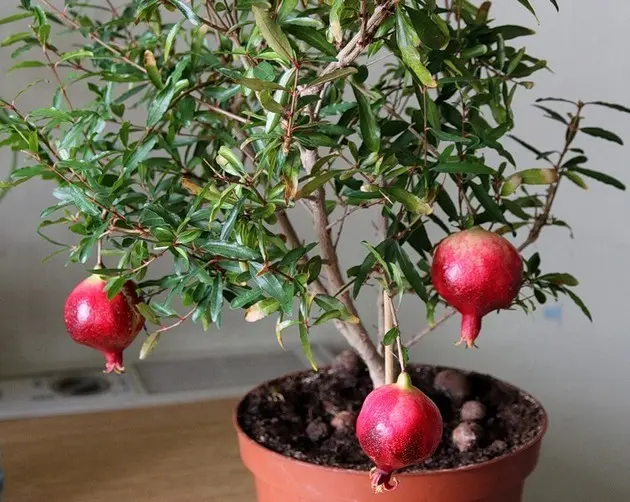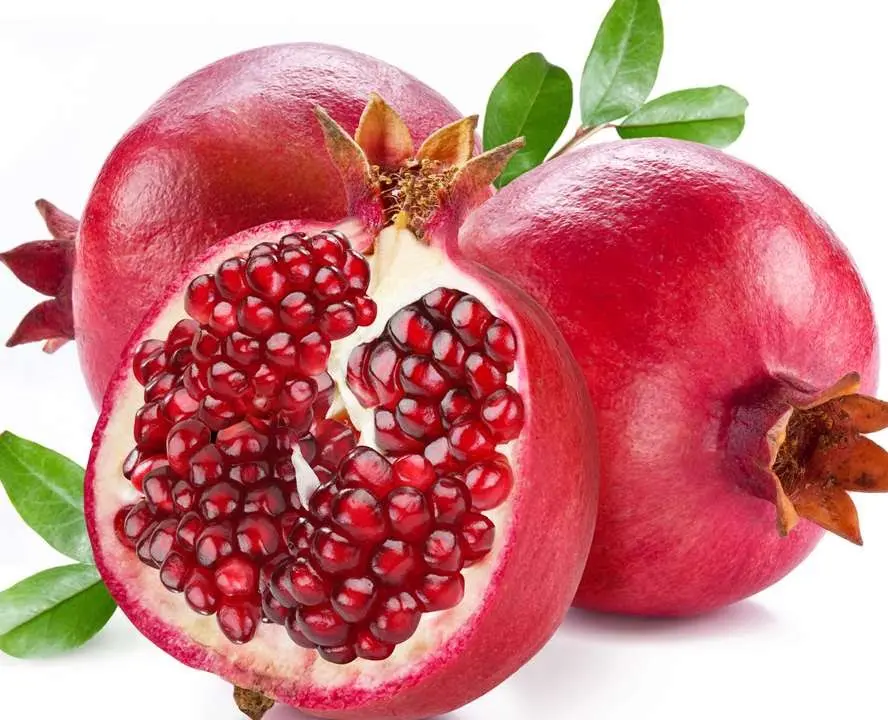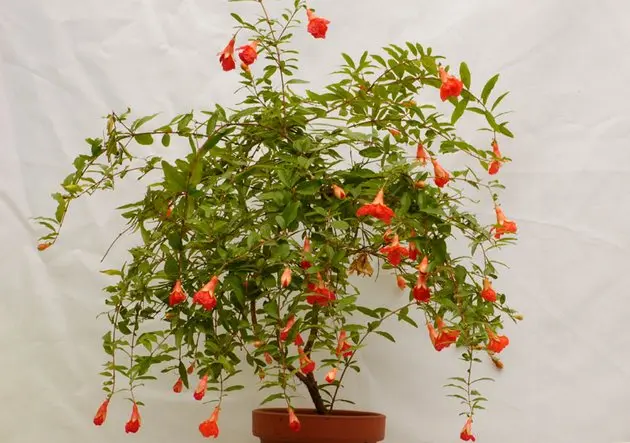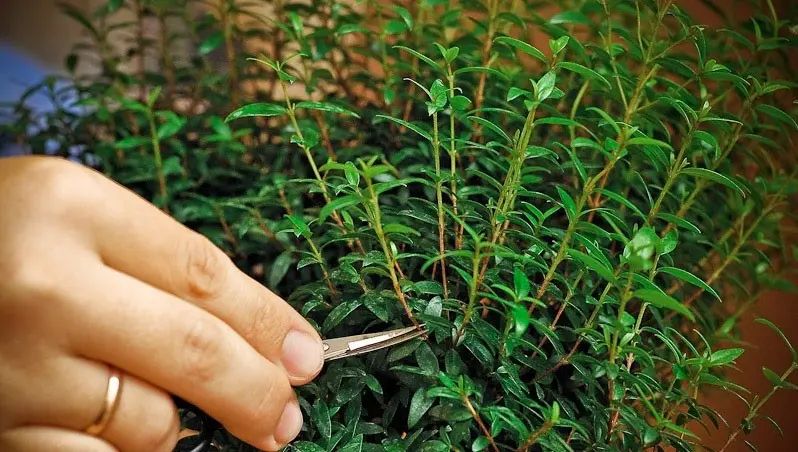Contents
Dwarf or indoor pomegranate is a miniature ornamental tree intended for home cultivation. Of all the representatives of the exotic flora, it is perhaps the most unpretentious, therefore it quite easily adapts to the microclimate of the room. Growing indoor pomegranate in the house is a fascinating and enjoyable activity, because in addition to exceptional decorativeness during flowering, the culture is able to bear small, but quite edible fruits.
Growing from bone and seed
Fans of exotic domestic plants may be interested in the question of where to get and how to grow a dwarf pomegranate on their own. After all, ready-grown trees in flower shops have a very considerable cost. It should be said that indoor pomegranate reproduces well by cuttings and seeds. The seed method has several options, but its effectiveness is low, since it takes more time to grow a full-fledged tree, and the seeds do not always germinate.
For breeding homemade pomegranate, you can use several options for seed:
- seeds purchased in specialized stores – they have the highest percentage of germination;
- seeds formed in the flower of a dwarf pomegranate growing in the house;
- seeds extracted from fresh homemade pomegranate fruit.
It makes no sense to use seeds from an ordinary pomegranate bought on the market, because even if they yield, the tree can bloom only after 7 years, and the dimensions of such a plant are completely unsuitable for the room.
In order for the seeds to germinate, they need to be properly prepared and planted. If the material is purchased in a specialized store, then, as a rule, it is enough just to soak it for a day in water, and preferably in a growth stimulator (Kornevin), and then plant it in moist soil. If the seeds are taken from fresh fruit, then first they must be separated from the pulp, rinsed well, and then dried properly – this will help to avoid rotting of the material. Then everything is as in the previous case: soak for a day in a growth stimulator, and plant in the ground.
Sowing seeds is carried out in the spring, around mid-April. For planting, a substrate is used, consisting of equal parts of sand and peat. Sowing is carried out in moist soil to a depth of 0,5-1 cm under glass or film. The pot with seeds is placed in a warm place, since they need a temperature of at least +25 ° C for germination. High-quality material rises quite quickly. When 2-3 true leaves are formed on the seedlings, they are seated in separate pots along with a clod of earth. For further development, plants need a warm and humid microclimate. For better branching, pinch the largest branches.
Video “Growing”
From the video you will learn how to grow pomegranate in different ways.
Growing with cuttings
It is easier to grow indoor pomegranate from a cutting than from seeds, moreover, this method has a higher survival rate. Planting material is taken from an adult fruiting plant in spring or summer. Cuttings 10-12 cm long are cut from a strong and healthy stem, so that they have 4-5 live buds. Next, these blanks are placed in a growth stimulator, after which they are planted at a slight angle in a moist substrate.
For better rooting, the cuttings are covered with a jar or a cut plastic bottle, maintain soil moisture, and ventilate daily.
With proper care, after a month, roots will begin to grow on the cuttings, and buds will bloom. After another two months, the plants can be planted in separate pots. A tree grown from a cutting fully blooms for 2-3 years. The buds that appeared on the plant in the first year should preferably be cut off.
Care
Growing indoor pomegranate, home care is quite simple to provide. The main thing is to try to create a suitable microclimate. Light, temperature, air and soil humidity are of great importance for a tree. At room conditions, it is better to place a pot with a plant on the windowsill (but not on the north side), and in summer take it out to the balcony. Remember that direct sunlight can cause burns, so in hot weather, the pomegranate should be shaded or placed in partial shade. In autumn, the tree is returned back to the room.
Pomegranate is a heat-loving crop. For its normal development, flowering and fruiting, it is necessary to maintain the air temperature in the range from +20 to +25 ° C.
If the room is stuffy in summer, and the temperature exceeds +25 ° C, the tree may begin to shed its leaves, so it should be taken out to the balcony and periodically sprayed with cool water. When fruit ripening begins, the temperature should be slightly lowered, to +16 ° C. The lowest temperature that indoor pomegranate can withstand is +6 ° C, below this indicator the plant dies.
Pomegranate is watered in different modes, depending on the stage of its vegetation and weather factors:
- during active vegetation, as well as in hot weather, the plant needs a lot of moisture – starting from February, the pomegranate is watered regularly, as soon as the topsoil dries;
- during flowering, the frequency of watering is slightly reduced, but make sure that the soil does not dry out, as the buds may begin to fall;
- after flowering, the number of waterings is increased again – this measure contributes to the abundant flowering of the tree next year;
- during fruit ripening, watering is carried out carefully, since excess moisture can lead to cracking of ripe fruits;
- in winter, the plant begins a dormant period – at this time it is watered very rarely, only so that the roots do not dry out.
To maintain the decorative effect, indoor pomegranate needs to be fed about 1-2 times a month. In spring, nitrogen fertilizers are applied, in summer, before and after flowering – a complex mixture with phosphorus, during fruit ripening and in late autumn – potassium. Fertilizers are applied in liquid form by irrigation. Top dressing is best done in cloudy weather or in the evening. In the middle of autumn, top dressing stops.
Like any houseplant, pomegranates can get sick and be attacked by pests. Since the tree loves moisture, it is sometimes affected by powdery mildew, a fungal disease that develops against a background of high humidity, and manifests itself as white blooms on the leaves. If signs of disease appear, reduce humidity (stop spraying and watering the plant). Due to excessive moisture, the roots may rot and the leaves may turn yellow.
Pomegranate pests are sometimes attacked by scale insects, spider mites or whiteflies. As long as there are few insects, they can be collected by hand. If the population has increased, then chemical agents should be used (Aktellik, Fitoverm). The same drugs can be sprayed on the tree for prevention purposes.
Trimming
The formation of a crown for a homemade pomegranate is a common thing, because the culture is mainly grown for decorative purposes, and not for the sake of obtaining fruits. In this case, pruning not only rejuvenates the plant, but also gives it an original decorative shape. As a rule, a pomegranate tree is cut once at the end of winter, in February, when bud formation begins. At the same time, it is moved from the cold to a warm room (room), and they begin to cut dry, not yet blossoming twigs. During this period, the pomegranate best tolerates the pruning procedure.
To make the tree lush, you need to cut off the young shoots above the bud, looking outward, leaving 4-5 internodes. In order to avoid excessive thickening of the crown, the buds directed inward, as well as all small branches, should be cut off. You should not get carried away with pruning, as it can weaken the plant. For an indoor tree, it is enough to leave 5-6 skeletal branches. When pruning, remember that pomegranate flowers are formed on only the most developed annual shoots. Sometimes, with excessive branching, there is a need for unscheduled pruning in the summer. When removing shoots during the active growing season, it is imperative to close up the places of cuts with garden pitch.
Transfer
In the first three years, indoor pomegranate, which is grown in a pot, should be replanted annually. At first, the tree grows quite intensively, and if it does not have enough land and nutrients, then soon the plant will begin to hurt and lag behind in development. Upon reaching the age of three, transplantation is carried out 1 time in 2-3 years, mainly in the spring. Technically, this is very simple to do, since the transplant procedure consists in transferring the tree into a larger pot along with the ground.
The root system of the pomegranate is fibrous, well developed, and grows more in breadth than in depth. But this does not mean that the pot for the tree should be large and wide. Every year it is enough to increase the diameter of the pot by 3-4 cm (about 0,5 l). The soil for growing pomegranates needs neutral, consisting of soddy soil or black soil with the addition of sand. You can buy ready-made store soil for roses, as long as its acidity is neutral. A drainage layer in a pomegranate pot is required, as excess moisture can harm it. Remember that in nature the pomegranate tree grows on rocky terrain – try to create similar conditions for it. If the roots are in a little tightness, the pomegranate will bloom more luxuriantly.
Like all trees, indoor pomegranate needs rest. This period begins after the ripening of all fruits – around the beginning of December. When the tree begins to drop leaves, care should be taken to create suitable conditions: lower the temperature to + 10-12 ° C, and reduce watering to a minimum. If the house has a basement, a pot of pomegranate can be taken out there for two months. In the conditions of a city apartment, it is more difficult to ensure such a temperature, therefore, in the absence of a heated loggia, the plant is moved closer to the window glass and fenced off with dense material from the rest of the room. In the cold, the plant is kept until February, after which the tree is ready to bud again.
Video “Care”
From the video you will learn how to care for a pomegranate.









